Charlottesville’s Lee statue will be given to the Jefferson School African American Heritage Center (JSAAHC) to be melted down into bronze ingots and repurposed for the museum’s Swords into Plowshares proposal. In a Monday city council meeting that ran late, councilors voted four to zero to approve the proposal.
The vote happened after discussion focused on the disposition of other removed city statues of Stonewall Jackson and Lewis, Clark, and Sacajawea. Seeking more information, the council decided to postpone decisions until later in the month, but public commenters at the end of the meeting asked the council to make a decision, leading to the final vote on just the Lee statue. Vice Mayor Sena Magill was absent.
“I’m not opposed, I just thought it would be nice to do all of these things at once, and I also thought it would be nice to have all five counselors here at once to do it. But if there’s a will to do this tonight, and we cannot wait, I don’t think that it’s going to change the outcome whether we wait or not, but obviously some people have that concern. I’m just sorry that we don’t have all five of us here,” Council Member Heather Hill said.
“‘Swords Into Plowshares’ (SIP) proposes to articulate Charlottesville, Virginia’s 1924 monument of Robert E. Lee as a new work of public art that expresses the City’s values of inclusivity and racial justice. Inspired by the prophetic vision of transforming ‘swords into plowshares’ (Isaiah 2:4), SIP would fund the transportation, disassembly, and melting down of the statue; an extensive community engagement process; and ultimately, the commissioning of an artist-in-residence committed to that engagement to repurpose its bronze for a new piece or pieces of art,” JSAAHC Executive Director Andrea Douglas said in the October proposal.
History of the Statue
In 1918, the city accepted philanthropist Paul Goodloe McIntire’s offer for a donation to create a park and erect the statue of Lee. The statue was erected in 1924. Self-taught artist Henry Shrady began the statue, and Leo Lentelli completed it after Shrady died, according to a National Register of Historic Places Registration Form. Shrady also sculpted the Ulysses S. Grant Memorial in Washington, D.C.
“Lentelli, however, did not give Lee and Traveller the vitality Shrady had envisioned, for Shrady’s small model of the sculpture, now at the Jefferson-Madison Regional Library in Charlottesville, shows animation, while Lentelli’s larger figures are quieter but more dignified and powerful,” states the 1996 registration form by architectural historian Betsy Gohdes-Baten.
“Sentiment in Charlottesville will undoubtedly keep [the Lee sculpture] there, for the monument is a unique to the most eminent Confederate hero of all and an outstanding example of the outdoor sculpture of the late City Beautiful movement,” the form concludes.
Determining the fate of the statue has been a long process.
In February 2017, the city chose to remove the Lee statue, triggering a lawsuit. Then, in the wake of the deadly Unite the Right rally, the city reaffirmed its decision to remove the Lee statue and decided to remove the Jackson statue as well, according to court documents.
That lawsuit went to the Virginia Supreme Court, which ruled in favor of the city in April. The city removed the statues in July.
Removal of the monument was opposed by a different lawsuit that went to the Virginia Supreme Court, which ruled in favor of the city in April. The city removed the statue in July.
Other localities in Virginia including Richmond and the Commonwealth itself have also removed Confederate monuments, many of which are now in storage. Some proposals under consideration in other localities include transferring the statues to private organizations including museums and cemeteries.
Councilor Lloyd Snook told The Virginia Star, “I don’t know whether other communities have chosen to destroy a Confederate monument rather than to simply move it. One precedent that comes to mind was the 1776 decision to tear down the statue of King George in New York and melt it down into bullets. I would assume that there are more recent examples, but I don’t know.”
He referred to the SIP proposal, where Douglas writes, “Recontextualization is not enough. Even taken from its pedestal and removed from its central location in downtown Charlottesville, the social codes engendered by the Lee statue will allow it to remain an icon of violent white supremacy wherever it is placed. Transformation is different from destruction: the new piece of art will draw meaning from the fact that it will be formed from the very materials that were once used in the Lee statue.”
State Senator Mark Reeves’ (R-Spotsylvania) district borders Charlottesville. Reeves has opposed contextualization efforts over Richmond’s monuments. In July, Reeves wrote to the Charlottesville City Council arguing that recently-passed state law does not allow localities to alter or destroy monuments and only grants authority to contextualize them to the Virginia Department of Human Resources. He proposed relocation to a state battlefield.
“What does it say of a society that destroys its works of art? What does it say of a society that burns its books,” Reeves wrote. “I participated as a conferee to guarantee the survival of these valuable works of art. You can love them or hate them, but you cannot alter or destroy them.”
Congressman Bob Good (R-Virginia-05) represents Charlottesville. He told The Star in a statement, “Sadly, the elected leaders of Charlottesville have demonstrated time and again that one of their highest priorities is to become the capital of cancel culture. They are more interested in political stunts that divide Virginians than in identifying positive ways to move forward toward what our founders hoped would become a more perfect union.”
Good said future generations should study Lee’s roles as college president, military strategist at West Point, and his post-Civil War reconciliation efforts.
He said, “I am against efforts to erase southern history and heritage, including removing Confederate monuments. However, I believe that the federal government should leave these decisions to state and local governments, who are more closely connected and accountable to citizens.”
Swords into Plowshares Plans
Douglas told The Star that the SIP proposal’s goal is to create a high-quality public artwork with the same gravitas as the original.
“It is a stated value of the City of Charlottesville from a policy basis that it believes in equity. And in terms of that position, this needs to be a full community-engaged conversation, which is far different from how those statues became part of our cultural landscape in the 1920s,” Douglas said.
“Certainly yes, it was a gift, but it was not a gift that at that point about 35 percent of the population could have a comment on whether they received it or not. This was a series of philanthropy that was based on a specific ideology, that as you know is the Lost Cause narrative, the creation of heroes that are then placed in public squares to talk about the sense of what a new South would look like within the City Beautiful Movement, which is also an aesthetic movement,” she said.
“The difference between now and then is that we are recognizing that the Charlottesville population is much more plural. It is not just about an African American population versus a white population. There are Latinx people who live here, there are Asian people who live here, there are new immigrants who live here, and we’d like to create a more democratic process as it relates to our public space, and that’s what we’re attempting to do,” Douglas said.
JSAAHC has $590,000 of the estimated $1.1 million needed to fund the project and is crowdfunding for the remainder as part of the plan to make sure the project doesn’t represent one philanthropist. Douglas said that since the decision was just made, details are still being worked out, but the next step will be a community engagement process likely starting in February and ending by midsummer with a document of guidelines for the artist that can also be used by the city. Then, JSAAHC will issue a request for proposals and will commission an artist, with completion of the process expected by 2024.
Douglas said there are no strings attached to the city’s plan to give the statue to the JSAAHC, which intends to offer the re-imagined art to the city as a public artwork.
Douglas emphasized that anyone can be involved in the re-imagining process, including people who disagree with the decision to remove and melt the statue. People who want to participate can donate to the fund, and should watch the JSAAHC social media for announcements about how to participate in the community engagement process.
She said, “If you feel you have a stake in this process, meaning you want to save or to bring in any of those cultural references, you can come and participate in the community engagement process as well. I don’t see this as a process that does not want to hear the voice that says, ‘These statues represented my ancestry.’ That to me is a position, and that position should be represented in this process as well.”
– – –
Eric Burk is a reporter at The Virginia Star and The Star News Network. Email tips to [email protected].
Photo by Eric Burk.








I’ll be writing Virginia’s legislature over this. Virginia is out of control with hatred.
This ought to be stopped by the new Virginia General Assembly and Governor. In the meantime, this ought to be ‘tied up’ in court and prevented from happening until the General Assembly can act. These beautiful works of art are to be destroyed just so communist Democrats can vent their spite! Mark my words, if these evil people can do this to Lee, one day they will try to do it to Jefferson and Washington and Madison and Monroe and Mason (and Jackson too) etc. Enough! Stop this!
Amen!